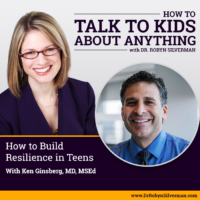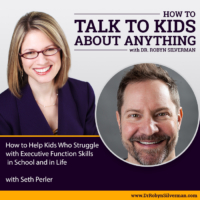Podcast: Play in new window | Download
Subscribe: Apple Podcasts | RSS | More
How to Help Kids Build Healthy Technology Habits with Diana Graber

This podcast will focus on talking to kids about navigating the digital world. How do we help them to shape their digital reputation? Use apps? Understand how to cope with cyberbullying, sexting or exposure to possible predators? Dr. Robyn Silverman interviews Diana Graber for a second time.
Special guest: Diana Graber.
Are you concerned with how much screen time your kids are using? What kind of digital reputation they are creating or how their self-esteem in being impacted by certain apps, cyberbullying, sexting or exposure to possible predators? How about clickbait, deep fakes, fake news or the like? There’s a lot of information out there and it’s here to stay. We can’t stick our heads in the sand and simply say, “I wish all of this technology didn’t exist” or “I remember when I was young and didn’t have to contend with that- can’t we just go back?” This is when and where our children live. The cyber world is just “their world.” We need to know how to navigate it and help our children navigate it with confidence, responsibility and knowledge. They need to learn how to become tech savvy and cyberwise. For this discussion, we are going to talk to our friend, Diana Graber, for a second time. There’s been a lot since last we talked!
Diana is the author of “Raising Humans in a Digital World: Helping Kids Build a Healthy Relationship with Technology”(HarperCollins Leadership ’19), co-founder of CyberWise (aka, No Grownup Left Behind!) and founder of Cyber Civics, the popular middle school digital literacy curriculum. Today Cyber Civics is taught in schools in 48 US states and internationally, and it was honored as an “Innovation in Education” finalist by Project Tomorrow and the O.C. Tech Alliance. Graber is a regular contributor on digital media topics for Psychology Today and others, and is regularly interviewed by the media regarding tech topics. She’s been an Adjunct Professor of Media Psychology teaching “Media Psychology for the 21st Century” and she presents regularly (virtually since COVID) to schools and community organizations across the US and she also conducts teacher workshops.
Important Messages:
- Have to embrace the world the kids live in now- even if sometimes we wish it were different.
- Screen time big issue with kids. Take a hard look at what the kids are using screens for. (1) Schoolwork (2) Maintain connections with friends. What are kids using screens for is the more pressing question. Look something up? Continue a conversation? It’s about content not the time.
- Hold off social media as long as you can. Social media is for 13 and up. (1) Required. (2) Takes up to 13 years to build up the ethical thinking skills they need when encounter things on line. (3) Content- kids get news from devices. Think of a 9 year old getting news online right now (Ukraine attack).
- True or false: Kids should be able to be locked in their rooms online (depends on age)
- Kids should be able to make their own plan of how much screen time they use. (Work together- agreement how much screen time is appropriate based on age, stage, use)
- Video gaming is harmful to my child’s mental health. (depends. Are they playing alone? With friends? What are they playing? Who are they playing with?)
- Tik tok and snapshat are harmful to my child’s mental health. (both of these are tools- not inherently bad or damaging depends on what they are using them for- what are they looking at? Unattainable images of beauty- damaging. Vs. interested in climate change. Content really matters.
- Reputation management: You say that A good online reputation helps kids get into college and land the jobs of their dreams! According to Kaplan Test Prep, more than two-thirds of colleges (68 percent) say it’s “fair game” to review an applicant’s digital reputation. Nearly one in ten colleges surveyed said they had revoked an incoming student’s offer based on something they found online. So, should parents be worried? What are parents really worried about– and what should we be telling our children to ensure that they see what they put on social media can inform how they are perceived now– and later? Hold off- could impact their future. Schools in California no longer using test scores. If there is a question about a child, they are going to go to social media.
- Anything you put online stays online forever. Don’t think of long term consequences. Have the conversations before they start using online vehicles.
- Put up positive things to show what a good person you are. (Create a reputation that’s positive not just avoid a reputation that’s negative.)
- Exercise: Even commenting on people’s posts contributes to your reputation. Let’s practice commenting thoughtfully and respectfully. Not “that sucks” instead “I have some concerns with this” or “I respectfully disagree and here’s why. What do you think about that?”
- Post or not? Would your grandmother like to see this? Would your mother like to see this? Consider what an adult would say- eyes of any adult.
- Exercise: Who would they choose for admission if they were the college counselor based on what they are seeing online—what each person posts and what they comment. Hard on themselves. Review two fake applicants. Translates- pause before they post. (Remember, a college scout can be making some pretty important decisions about your future based on your past!)
- When a child/teen is posting, they are only considering that their only audience is their peers. They are trying to show off, they are trying to be funny, they are trying to fit in. Forget- audience can be adults, adult relatives, people they don’t know. Reminds them that there are more people out there seeing what they post.
- Safety/fairness/should I post?
- Don’ts: Lecture. In one ear out with another.
- Don’t use feat tactics
- Don’t take devices away if they make a mistake. Will hide things if think device is being taken away. Research says.
- Dos: “Always remember that behind every screen is a real person with real feelings.” Consider effect it has on others. If they tag a friend then it contributes to their friend’s digital reputation too.
- Dos: Would your grandmother like to see this?
- Cyberbullying Research Center shows about 28% of students say they have been the victim of cyberbullying at some point in their lives. Even more will observe others being cyberbullied. The moment you give your child a connective device. Many kids cyberbullied- and disturbing how many will witness cyberbullying and not react appropriately. Conversation: What to do if you see it. Online everyone sees it. Upstander. (1) Give comfort to target. (2) Report it to social media network. (3) Talk to a trusted adult so they can step in if needed. If they did these things, there would likely be a lot less cyber bullying
- Operate behind avatar. Forget it’s a real person. On front side- these are the qualities my avatar portrays to the world vs the back- these are 3 things I wouldn’t want people to know about me. Kids draw avatars that are brave and strong but admit they are hiding that they are sad or shy. Read aloud. Good to remind kids that they are not seeing the big or full picture. Everyone is hiding behind something. We talk about Facebook and everyone looks like they are living their best life. In the real world, that’s not the case. Everyone has the same issues and problems. There’s a person behind there- just like there is a person behind yours. Someone behind there who is feeling hurt.
- Self esteem. Are Instagram, tik tok, snapchat and other similar apps a danger to our child’s self-esteem? They can be. Instagram- facebook files. Visually driven. Snapchat- silly picture and disappears. IG- your pictures become your profile. They want everything to look pretty. They want it to match. A lot of pressure to have these idealized stereotyped images. Contributes to low well being. Talk about stereotypes. Talk about doctoring images. Facetuning. Curated images- facetuned. How it works. Social media likely not changing. Beautiful images have been part of media forever (this is new iteration). (Cosmo, Vogue).
- Doctored images- original to doctored image. Here we are having the same conversation now. Big aha moment. Important to have that moment with kids. Take them through the steps. It takes a second to make someone look beautiful online. Lots of growth during covid.
- It’s considered sexting whether you are the sender or receiver. Serious if you get caught. If you have the image on the phone. Sexually provocative photo. Laws haven’t caught up- considered child porn. Serious. Right after digital literacy. Celebs are almost naked on covers- but if they exchange the same kind of images, illegal.
- Start early. Raising a human is like building a house. Lots of parts. It takes time and planning. Same as digital parent. Write the email together with your child on your lap- using kind words. Then when they are using an app, check in. Video games together- who playing with, how work, let’s both get tiktok together. Used to having you in their world. Just like you are in the same neighborhood when they are playing, you are going to be in the same neighborhood as them when they enter the digital world.
- When you start by looking over the shoulder when they are a teen, that’s problematic.
- You want snapchat? Let’s get it together. They do chatting on snapchat and tiktok and IG.
- You want everything to remain open so you can talk to them and they can talk to you about the digital world. Confusing, scary, they don’t understand- want them to come to you with those questions.
- Fake news. Click bate. Deep fakes. Kids are doing research for school. What to click? Provocative. Bated to click on something. (My son bated to press on something related to a game- I’m not going to fall for that!)
- They must teach this at middle schools! Want them to use tech? They need education.
- To understand information literacy- how does search work? Are you getting ads? Sponsored content? How do you know if it’s click bait? What is algorithms? How do you know what’s true or false? Not a one time discussion. Have to understand how the whole ecosystem works. Digital literacy is today’s literacy. It takes a while to teach a kid how to read a novel. You don’t just hand a kindergartener a novel, you take them through the steps of how to get there. It’s the same thing with learning how to get information off the internet. They have to understand a lot of things in order to be a really savvy internet researchers.
- Young kid- Ask questions. Do a search online. Who wrote this? Who is the author? Is this a real person? Does this person know what they are talking about? Look up the author. Who is this author? Do they know about trucks?
- Are things paid for? Natural article? Why did they sponsor this? Why did they pay for it? Why did they want you to read it? Then when older and are doing research on vaccines or controversial topic- they don’t just read the headline and take it as truth. They read the article, second site, they look up the author, they find a second article, they find out who the writer is and why they wrote it.
- It’s written and black and white- not necessarily true!
- Hand in hand. Rabbit holes. Super typical. Watch video on insects. Then youtube is going to recommend more and more videos on insects. Super narrow window into the world. “You don’t want any child looking at the world through a microscope. You want them to see all kinds of things.” How to break out of those filter bubbles.
- How do we guard against plagiarism? So much pressure to succeed and have a good-looking digital reputation. What is it? Consequences? What to do instead of highlight and paste. Skill- paraphrase. Cite appropriately. This is how you can do this so you don’t get caught. Also being an ethical user. Imagine you are a creative person and someone just took something you created and used it and didn’t give you credit or money for it? Drive that concept home. That might be YOU someday! So many great plagiarism checkers. Prepare for the world!
- Rules in home- around screen behavior. Hard and fast- advocate for- come up with norms that your family thinks is very important. For example, norm- permission before post a photo online. Or, no texting after 9pm or before 6am. Turn off phone at this time. Come to them together. Agree to- our tech norms in family.
- Digital leadership- want our kids to use technology safely, productively and ethically. (1) Remember behind every screen is a real person with real feelings. (2) Send kids off with the ability to do research correctly. Paraphrase other people’s work. Know how to read articles. Know how to cite.
- Top tip. When you think about digital parenting. Think about being a dolphin. A dolphin is curious, playful, yet they are firm and flexible. Talking to them- coinvestigating. Kids use tech because it’s fun! It’s where their friends are. Hold your line too. Agreements. Flexible as they grow and learn more. Guiding child towards independent digital learning.
Notable Quotables:
- “Let’s throw out the term ‘screen time’ and instead focus on ‘screen use.’ What are kids using screens for?”
- “Sit with your child and together, determine how much screen time is appropriate for them dependent on age and stage and use.”
- When assessing whether what your child is doing online is damaging or not, content really matters.
- “Anything you put online stays online forever and can be seen by anyone at any time.”
- “Today, our social media is our calling card. It’s where people go to find out what kind of person you are.”
- Before they post, we want kids to ask themselves, what would your grandmother think of this? Your mother? We want kids to consider what they post through the eyes of an adult.”
- “Always remember that behind every screen is a real person with real feelings.”
- “Join snapchat and tiktok together. Let them get used to you being in their world. Just like you are in the same neighborhood when they are playing, you are going to be in the same neighborhood as them when they enter the digital world.”
- “I keep coming back to the name of your podcast- How to Talk to Kids about Anything- that’s what it’s all about! You want everything to remain open so you can talk to them and they can talk to you about the digital world. They are going to encounter things that are confusing, scary, they don’t understand- want them to come to you with those questions.”
- “You don’t want any child looking at the world through a microscope. You want them to see all kinds of things.”
- “We want our kids to use technology ethically, safely, and productively. They are a leader- and show people how to use it by example.”
Always remember that behind every screen is a real person with real feelings, says tech expert, @DianaGraber of @CyberCivics, on the How to #TalktoKids about Anything podcast. Listen in here
Click To Tweet
Resources:
Social Media for Dr. Robyn:
- facebook.com/DrRobynSilverman
- twitter.com/DrRobyn
- instagram.com/DrRobynSilverman
- facebook.com/HowToTalkToKidsaboutAnything
The post How to Help Kids Build Healthy Technology Habits with Diana Graber appeared first on drrobynsilverman.com.







